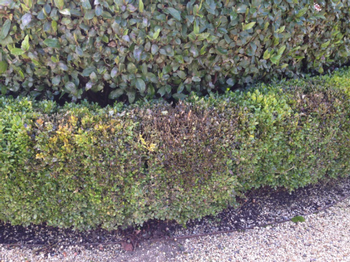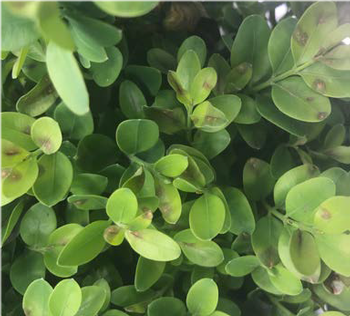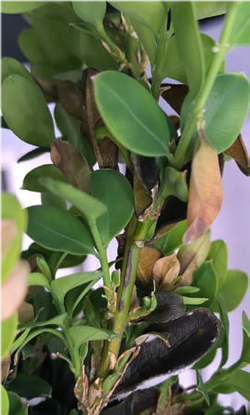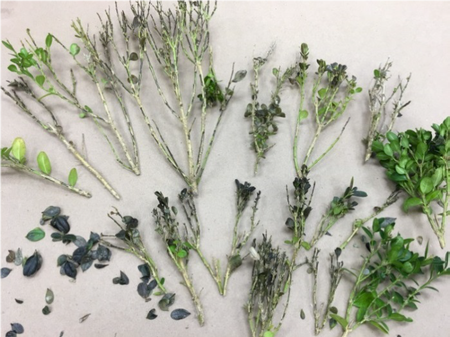Summer 2017 Field observations: Boxwood blight found in Bay Area residential landscapes
by Steve Tjosvold
Boxwood blight is a serious disease of most boxwood species (Buxus spp.), caused by the fungus Calonectria pseudonaviculata. Host plants also include the boxwood relatives Pachysandra terminalis (Japanese spurge), Pachysandra procumbens (Allegheny spurge) and Sarcococca species (sweet box); other susceptible plants may be identified in the future. First seen in the eastern United States in 2011, boxwood blight has now spread to the west coast. In California, boxwood blight has so far been identified in established boxwood hedges at three residences in San Mateo and Santa Clara counties. Nursery inspectors in California have been advised to look for symptoms of boxwood blight, but so far the disease has not been seen in California nursery stock.
Early symptoms include darkened, somewhat purplish discoloration of the foliage, and also tan to dark-brown circular leaf spots (fig. 1–2). Narrow longitudinal black lesions occur on the stems (fig. 3). Advanced disease presents as overall browning and defoliation (fig. 4).

Fig. 1. Darkened, purplish discoloration of the foliage caused by boxwood blight. Photo: CDFA.

Fig. 2. Boxwood blight symptoms include tan to dark-brown circular spots on leaves. Photo: CDFA.

Fig. 3. Narrow, longitudinal black lesions develop on the stems of a plant newly infected by Calonectria pseudonaviculata (arrow). Photo: CDFA.

Fig. 4. Boxwood blight symptomatic stems and leaves. Photo: CDFA.
The disease is primarily spread by transporting contaminated plant material (plants, decorative boxwood greenery), but spores can also be spread on pruning tools, clothing, equipment and anything that might have contacted infected plants. Wet or humid conditions and temperatures ranging from 64 to 80°F provide optimum conditions for infection and spread of the disease, and for defoliation of plants.
Boxwood blight is very difficult to control and eradicate. A combination of plant inspection, cultivar selection, rigorous sanitation procedures and fungicide application can be used to maintain boxwoods in a landscape where the disease is present. Some boxwood cultivars possess various levels of resistance, but none are immune. The home gardener might prefer to plant boxwood alternatives such as cultivars of Ilex, dwarf Picea, Thuja, Taxus, Euonymus, Myrica and Myrsine africana.
_________________________________________________________________
Steven A. Tjosvold
Farm Advisor, Environmental Horticulture
UC Cooperative Extension Santa Cruz County
1432 Freedom Boulevard
Watsonville, CA 95076-2796
(831)763-8013 phone, (831) 763-8006 fax
satjosvold@ucanr.edu












